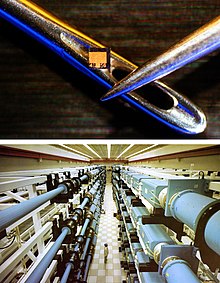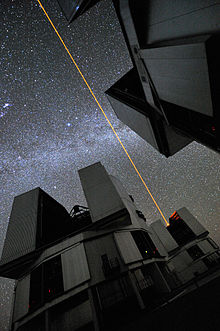
When lasers were invented in 1960, they were called "a solution looking for a problem". Since then, they have become ubiquitous, finding utility in thousands of highly varied applications in every section of modern society, including consumer electronics, information technology, science, medicine, industry, law enforcement, entertainment, and the military.
The first use of lasers in the daily lives of the general population was the supermarket barcode scanner, introduced in 1974. The laserdisc player, introduced in 1978, was the first successful consumer product to include a laser but the compact disc player was the first laser-equipped device to become common, beginning in 1982 followed shortly by laser printers.
Some other uses are:
- Medicine: Bloodless surgery, laser healing, surgical treatment, kidney stone treatment, eye treatment, dentistry
- Industry: Cutting, welding, material heat treatment, marking parts, non-contact measurement of parts
- Military: Marking targets, guiding munitions, missile defence, electro-optical countermeasures (EOCM), alternative to radar, blinding troops.
- Law enforcement: used for latent fingerprint detection in the forensic identification field[27][28]
- Research: Spectroscopy, laser ablation, laser annealing, laser scattering, laser interferometry, LIDAR, laser capture microdissection, fluorescence microscopy
- Product development/commercial: laser printers, optical discs (e.g. CDs and the like), barcode scanners, thermometers, laser pointers, holograms, bubblegrams.
- Laser lighting displays: Laser light shows
- Cosmetic skin treatments: acne treatment, cellulite and striae reduction, and hair removal.
In 2004, excluding diode lasers, approximately 131,000 lasers were sold with a value of US$2.19 billion. In the same year, approximately 733 million diode lasers, valued at $3.20 billion, were sold.
Examples by power

Different applications need lasers with different output powers. Lasers that produce a continuous beam or a series of short pulses can be compared on the basis of their average power. Lasers that produce pulses can also be characterized based on the peak power of each pulse. The peak power of a pulsed laser is many orders of magnitude greater than its average power. The average output power is always less than the power consumed.
| Power | Use |
|---|---|
| 1-5 mW | Laser pointers |
| 5 mW | CD-ROM drive |
| 5–10 mW | DVD player or DVD-ROM drive |
| 100 mW | High-speed CD-RW burner |
| 250 mW | Consumer 16x DVD-R burner |
| 400 mW | Burning through a jewel case including disk within 4 seconds |
| DVD 24x dual-layer recording. | |
| 1 W | Green laser in current Holographic Versatile Disc prototype development |
| 1–20 W | Output of the majority of commercially available solid-state lasers used for micro machining |
| 30–100 W | Typical sealed CO2 surgical lasers |
| 100–3000 W | Typical sealed CO2 lasers used in industrial laser cutting |
| 5 kW | Output power achieved by a 1 cm diode laser bar |
| 100 kW | Claimed output of a CO2 laser being developed by Northrop Grumman for military (weapon) applications |
Examples of pulsed systems with high peak power:
- 700 TW (700×1012 W) – National Ignition Facility, a 192-beam, 1.8-megajoule laser system adjoining a 10-meter-diameter target chamber.
- 1.3 PW (1.3×1015 W) – world's most powerful laser as of 1998, located at the Lawrence Livermore Laboratory
Hobby uses
In recent years, some hobbyists have taken interests in lasers. Lasers used by hobbyists are generally of class IIIa or IIIb, although some have made their own class IV types. However, compared to other hobbyists, laser hobbyists are far less common, due to the cost and potential dangers involved. Due to the cost of lasers, some hobbyists use inexpensive means to obtain lasers, such as salvaging laser diodes from broken DVD players (red), Blu-ray players (violet), or even higher power laser diodes from CD or DVD burners.
Hobbyists also have been taking surplus pulsed lasers from retired military applications and modifying them for pulsed holography. Pulsed Ruby and pulsed YAG lasers have been used.
No comments:
Post a Comment